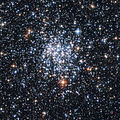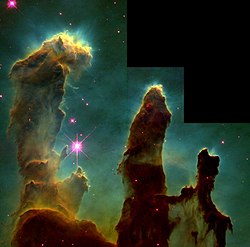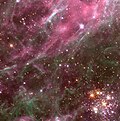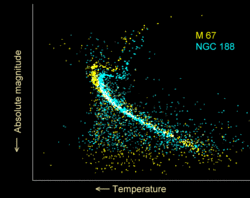Open star cluster
An open star cluster, also known as galactic cluster, is a group of a few hundred or thousand stars. They have roughly the same age, and were formed from the same giant molecular cloud.
More than 1,100 open clusters have been discovered within the Milky Way Galaxy, and many more are thought to exist. They are loosely bound together by mutual gravitational attraction, but they get disrupted by close encounters with other clusters and clouds of gas.[2] Open clusters generally survive for a few hundred million years, with the most massive ones surviving for a few billion years.
In contrast, the more massive globular clusters of stars exert a stronger gravitational attraction on their members. So, they can survive for longer. Open clusters have been found only in spiral and irregular galaxies, in which active star formation is occurring.[3]
Young open clusters may still be in the molecular cloud from which they formed. They light it up and create an H II region.[4] Over time, radiation pressure from the cluster will disperse the molecular cloud. Typically, about 10% of the mass of a gas cloud will form stars before radiation pressure drives the rest of the gas away.
Open clusters are key objects in the study of stellar evolution. The cluster members are of similar age and chemical composition, so their properties (such as distance, age and chemical composition) are more easily studied than for isolated stars. A number of open clusters, such as the Pleiades, Hyades or the Alpha Persei Cluster are visible with the naked eye.[5]
Open Star Cluster Media
The star cluster NGC 3590
NGC 265, an open star cluster in the Small Magellanic Cloud
Infrared light reveals the dense open cluster forming at the heart of the Orion Nebula.
The so-called "Pillars of Creation", a region of the Eagle Nebula where the molecular cloud is being evaporated by young, massive stars
NGC 346, an open cluster in the Small Magellanic Cloud
A cluster of stars a few million years old at the lower right illuminates the Tarantula Nebula in the Large Magellanic Cloud.
NGC 604 in the Triangulum Galaxy is a very massive open cluster surrounded by an H II region.
Hertzsprung–Russell diagrams for two open clusters. NGC 188 is older, and shows a lower turn-off from the main sequence than that seen in M67.
References
- ↑ Young stars paint spectacular stellar landscape. http://www.eso.org/public/news/eso1347/. Retrieved 20 November 2013.
- ↑ Karttunen, Hannu et al 2003. Fundamental astronomy. Physics and Astronomy Online Library, 4th ed. Springer. p. 321. ISBN 3-540-00179-4
- ↑ Payne-Gaposchkin C. 1979. Stars and clusters. Cambridge, Mass: Harvard University Press. [1]
- ↑ A good example of this is NGC 2244, in the Rosette Nebula. See also Johnson, Harold L. 1962. The Galactic Cluster NGC 2244. Astrophysical Journal 136: 1135.
- ↑ Neata, Emil. "Open Star Clusters: information and observations"o. Night Sky Info. [2] Archived 2012-09-08 at the Wayback Machine










